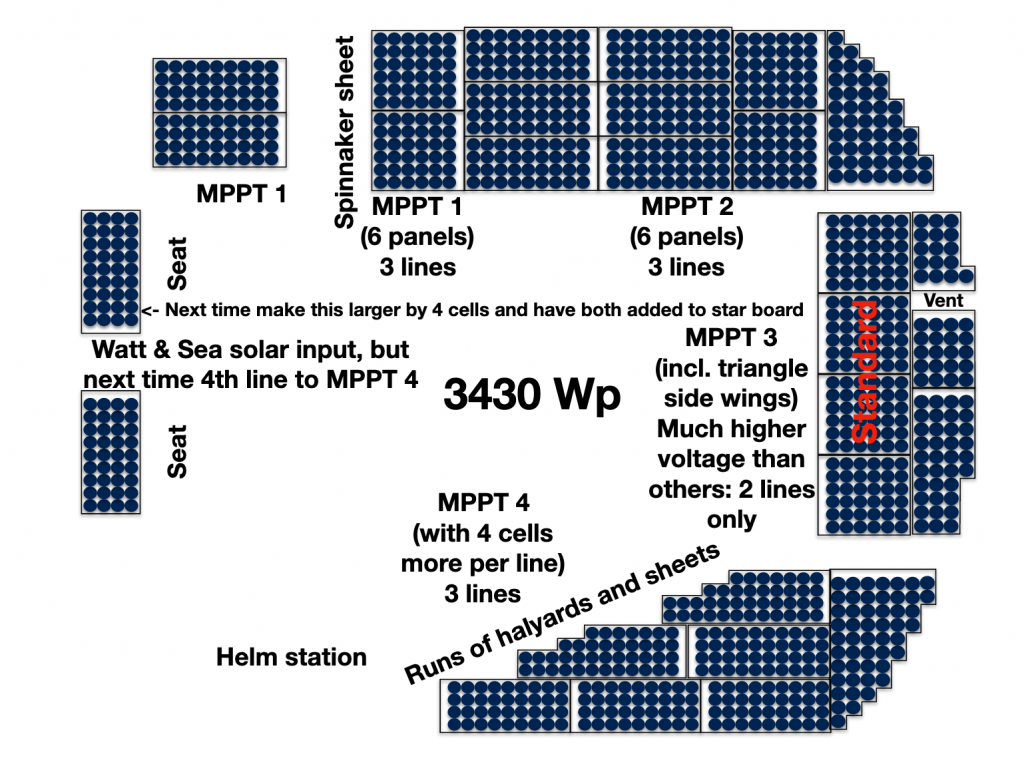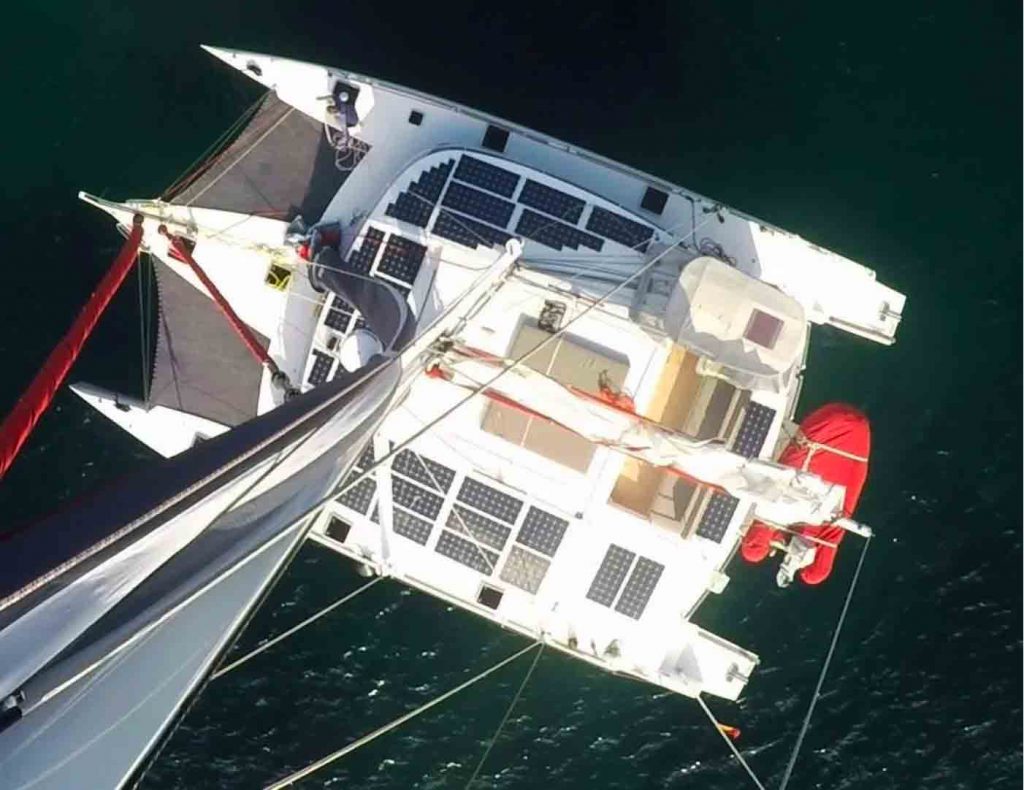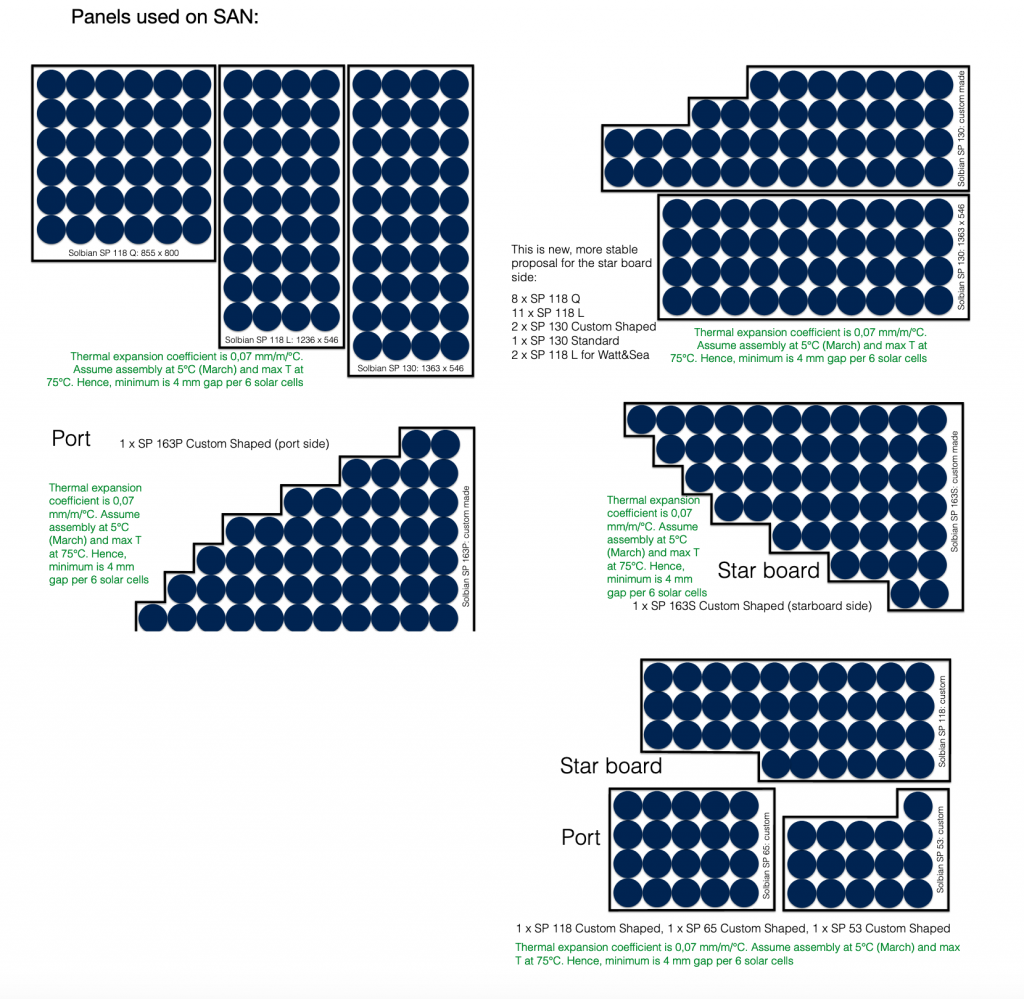Very Interesting owner’s post on how he outfitted the Neel 51 “San” with solar power.
On SY SAN we wanted to be completely autonomous for electrical power and not depend on Diesel to generate electricity. To this end, we designed a rather large system with many solar panels that is described in the following. The top layout of the flexible Solbian SP panels is as follows.

As the Neel 51 has a 24 V battery system, one needs to connect always two panels in series to achieve the required voltage. In total, we have 3430 Wp installed, but the two panels in the back are not really effective, as they are connected to the Watt&Sea solar input. The Watt&Sea solar regulator is rather poor compared to those of Mastervolt.
There are 4 Mastervolt MPPT 60 solar regulators that cover the three main sides the solar panels are facing. One MPPT regulator for the starboard, one for the front, and two for the port side (split into front and aft). The latter was needed as the concentrators used by Pochon to bundle the solar panels before feeding them to the batteries, called JB-5, can only take a maximum of 5 solar lines as input. But on the port side I have 12 panels organized into 6 lines, which are thus split up into 2 x 3 lines, feeding into two JB-5 boxes.
The MPPT 60 regulators all report to an EasyView monitoring unit so that I can see what has been produced every day. Only the Watt&Sea panels are not integrated in the same way. They report kAh to the EasyView, which is too large a unit to describe daily energy production accurately. The front panels are dealt with in a special way.

These are the panels right in front of the windows, and the triangular panels on the side. Those latter panels are somewhat delicate to glue onto the roof, having to be bent in two different directions, which solar panels never like. For monitoring purposes, I decided to have an electrical drop line between each panel and run this down the Runs of halyards and sheets Seat Seat Helm station Vent Spinnaker sheet 3430 Wp<- Next time make this larger by 4 cells and have both added to star board MPPT 1 (6 panels) 3 lines MPPT 2 (6 panels) 3 lines MPPT 3 (incl. triangle side wings) Much higher voltage than others: 2 lines onlyMPPT 4 (with 4 cells more per line) 3 lines Watt & Sea solar input, but next time 4th line to MPPT 4MPPT 1Standardblack support pillars between the front windows. The blinds there are easily removable and so it is very easy to check the system whether the voltage drop across each panel is what one expects.
Also, these front panels do not go via a JB-5, as the JB-5 can not accept voltages much higher than the 24 V. In fact, I am not sure the JB-5 is even designed for the floating voltage of two panels connected in series, but so far all seems fine. As these front panels are distributed over only two lines, a starboard and a port side line, their floating voltage can become very high, well in excess of 100 V. So, care needs to be exercised when connecting or disconnecting them. Because of this high voltage, these two front lines are connected via high voltage diodes with the batteries. Such diodes (or the JB-5) are needed to avoid having one string / line of panels discharge via another string / line that is in parallel but in the shade. The hope had been that the high operating voltage of the front panels mean they would start earlier in the morning to yield current and would be the last in the evening to shut down since their higher floating voltage would reach the threshold for charging earlier than the other panels. But this did not prove to be true.It should be noted that the panels on the starboard side have a slightly larger floating voltage than the panels on the port side. This was done to maximize the power available on that side. But it does mean that there is no mix and match possible between all the solar panel lines on the boat. As mentioned before, using the Watt&Sea solar input for the panels in the aft, behind the seats, was a mistake. It is a very poor solar regulator and, worse, the Watt&Sea can only handle solar or hydro, but not both at the same time. So, when sailing, the solar input goes to waste completely.
A better solution would have been to increase one of these two panels slightly to make them compatible voltage-wise with the solar panels on the starboard side, and then simply add them in parallel there, to the same JB-5 junction box.The batteries we use are 4 Li Mastervolt batteries of 24 V / 180 Ah capacity each, so totaling 17.28 kWh. This is the minimum of batteries to be used with so many solar panels. In fact, the system is usually limited by the batteries and charging stops already at midday or in the early afternoon. Other types of batteries are not really recommended as they cannot cope with the huge charging current these solar panels are capable of, and also cannot be drained as much as the Li batteries can. We have seen almost 90 A charging current at 24 V when conditions were best. Even when it is completely cloudy 30 – 40 A is quite possible. Consequently, we do not need to switch on the Volvo engine to have our water maker running. During a normal day the solar panels provide enough energy to have the watermaker (Freedom 100, 24 V), and still have a little surplus for charging the batteries. In fact, you can view the water tank as another form of energy storage on the boat, as it takes quite some energy to produce freshwater. The 600 liters in the tank require perhaps 8 hours of the Freedom 100 to run, at very roughly 25 A, so this is 4.8 kWh worth of energy stored. For two persons, we use slightly less than 100 liters per day. In the same spirit, the two Torqeedo batteries of 916 Wh each and the Brompton battery of 300 Wh are additional storage of electrical energy, resulting in total energy storage of roughly 24 kWh on the SY SAN.
How much energy do these solar panels yield per day? The answer is, we do not know, as for most days the batteries were fully charged well before sunset. Which is good, of course. Plotting our daily consumption by simply looking at what the panels yielded when the Volvo engine was not used at all during the day, we find that for two people at the anchorage on average we need 7.7k Wh per day. This includes washing machine, water maker, sometimes cooking with induction, all the toys (PC, power tools, etc), standard fridge & freezer, light, an hour or so of running the dehumidifier every morning, recharging the batteries for the electrical Torqueedo motor for the dinghy and the battery for the Brompton bicycle, but no air conditioning and no SSB. When four people are on board we have seen the average consumption go up to over 10-11 kWh (and I believe we had the SSB on standby all the time then), but also that demand the solar panels provided without any issues. The lowest battery level we have so far seen after a couple of cloudy days was 51%. The glass is half full! But all this also shows the batteries are slightly undersized. They store perhaps just two days of energy based on our daily consumption. Therefore, it is not really possible to take advantage of sunny days and store for the rainy days to come. But four batteries fit rather nicely in the technical room.
So, what would we do differently next time?
Perhaps look for an even smarter deck layout using some professional folks that can do this for Solbian panels. When designing the layout I had not realized the degrees of freedom I actually had.-Not use the Watt&Sea solar input, but add these two panels to the starboard, making sure that their voltage matches. Or go for a 5th MMPT and bundle these panels with some on port side. Or, perhaps the easiest, connect these two panels to the port side aft MPPT regulator.-Try to use lower voltages also for the front panels so that JB-5 might be used again. This may require a slightly different choice in the design of the layout of the solar panels. But this is more thought and I might well stick to the current design after more thought.



